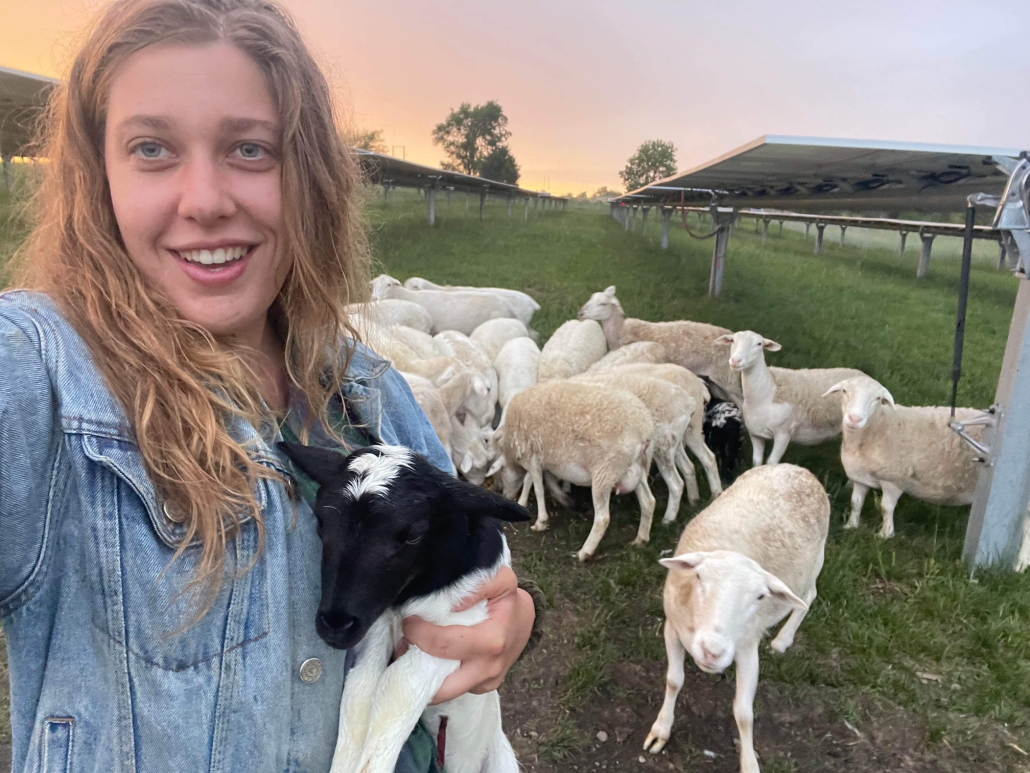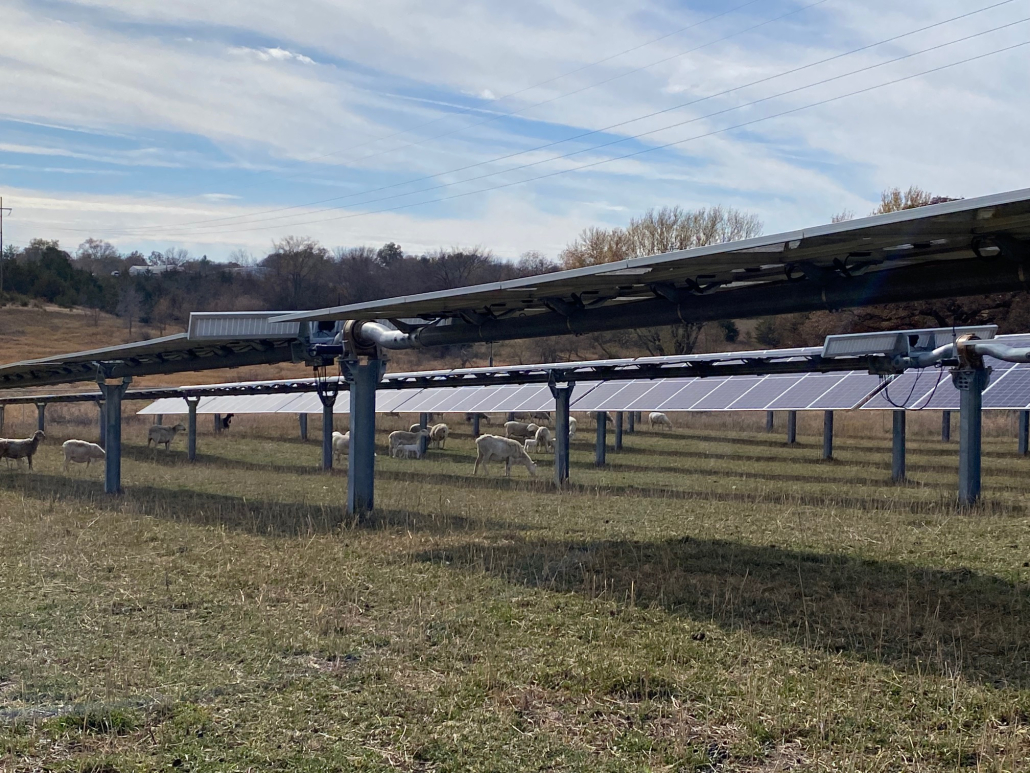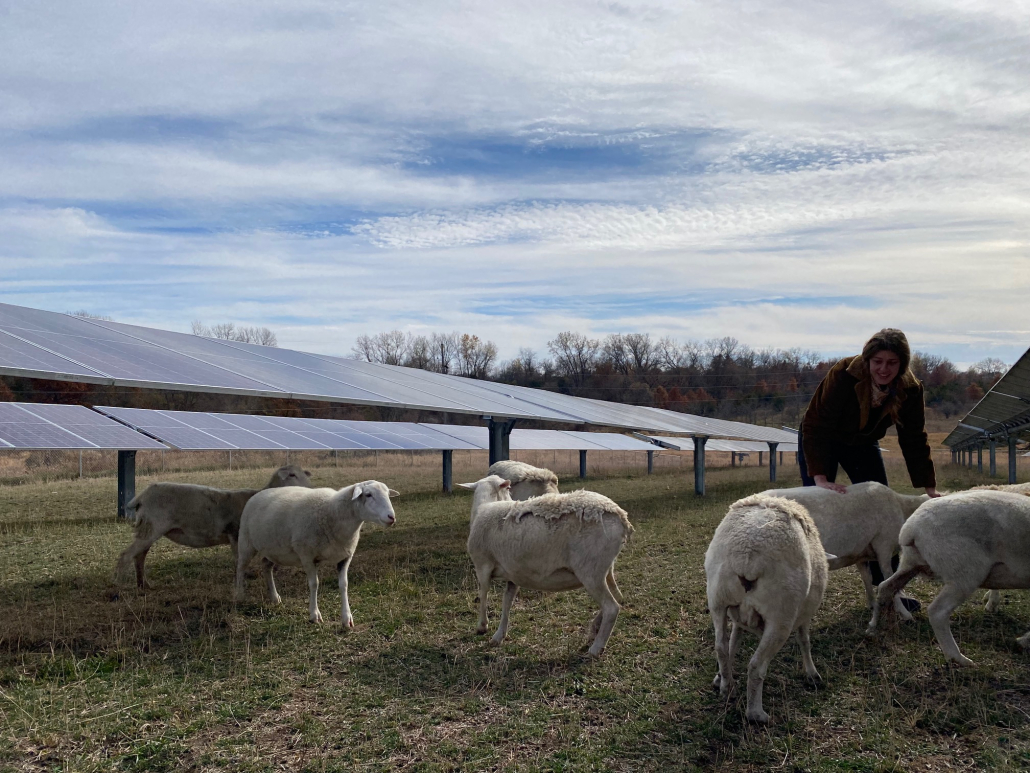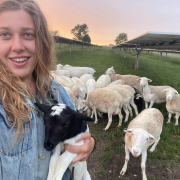Case Study: Mauntel’s Solar Sheep
Written By: Alex Delworth, Clean Energy Policy Associate; Center for Rural Affairs
Just off the campus of Maharishi University in Fairfield Iowa, sits a 1.1-megawatt (MW) solar farm. Beneath the panels, a flock of sheep and their newborn lambs are grazing, while beginning rancher Emily Mauntel and her Australian Shepherd Ziggy stand back and admire their work.
Solar farms pose a considerable opportunity for multipurpose agricultural uses in rural spaces. Iowa has seen a rapid increase in solar project development the past two years. According to the Solar Energy Industries Association, the industry is expected to add another 1,304 MW—a 250% increase over current installed capacity—during the next five years. Depending on the type of technology installed, this could mean between 6,520 and 13,040 acres of land will be used for solar production. With proper local siting, these projects will be required to plant and maintain native vegetation underneath the panels. This increase in open pasture presents a unique opportunity to combine traditional land uses with renewable energy development, such as pollinator habitats or open grazing for livestock. An opportunity Emily has already begun benefiting from.
Originally from Michigan, Emily relocated to Fairfield to attend Maharishi International University. While completing a three-month internship at a goat farm in Oregon as part of the university’s Regenerative Organic Agriculture certificate program, her interest in livestock grew. After the internship, she remained in Oregon for another year, working for various livestock operations and gaining experience in the industry. In late 2021, she moved back to Fairfield to work on the university’s vegetable farm and help her peers in their respective livestock businesses.

One day she and a friend were driving past a large solar array in Minnesota and noticed how the infrastructure was perfect for sheep grazing. They knew about the array in Fairfield, which is owned by the university and operated by Ideal Energy, a local solar company. She contacted the solar company to pitch the idea first and gained their approval before approaching the university. Both parties were ecstatic because the university had been looking for somebody to graze livestock and Ideal Energy saw an opportunity to avoid spending about $5,000 for annual landscaping, according to the company. Emily said the two parties came to an agreement that she would graze the array, which provided her an opportunity to access pasture in exchange for landscaping the solar farm. With this agreement, Emily benefited by not having lease payments for the time her sheep were on the farm, saving her approximately $360 per month according to Iowa State University’s land lease estimates, or about $2,520 for 2022.

Once Emily had approval, she and her friend went into business together and purchased a 30-head herd of sheep from an auction in Texas. In May 2022, 29 ewes and one ram were dropped off on the six-acre, 1.1-MW solar farm. Before purchasing the herd, she surveyed the land and determined that, given the amount of growth on the site, she would be able to graze five sheep per acre. That is two more than usual because of how lush the plant life was on the property. The site was planted with a mix of flowering prairie species, including clover, fescue, broad-leaf plantain, and others, which served as a good food source. The sheep were allowed to roam freely throughout the solar array, something Emily said worked well. Overall, she believes rotational grazing would have been more efficient but would have required a larger investment due to the cost of a moveable fence.

What makes this story especially interesting is that the agribusiness model directly addresses two major issues beginning farmers face—access to land and infrastructure. A 2017 survey by the National Young Farmers Coalition found that land access was the number one issue their respondents faced. Young farmers, according to the survey, are also the most inclined to rent, which makes finding land with the right infrastructure more difficult.
The Fairfield solar site’s infrastructure made the land even more attractive to Emily. She said it had sufficient fencing to hold her sheep and keep out predators. Due to the required native vegetation management, it also had plenty of food for the sheep, which means she never had to supplement food for them, except a mineral feed mix for nutrition. A water source to fill up the livestock troughs and an access road straight up to the gate also proved beneficial. Considering all of these factors, Emily was able to cut a lot of costs throughout the process.
Newly energized by the experience she has gained through solar grazers and managing her own livestock, Emily is now looking to return to the West to continue ranching. She and her business partner plan to sell their herd. Emily hopes to see the solar grazing model continue on the site, saying it has been a perfect opportunity for her to gain experience in the industry, and she believes it will be a great opportunity for the next person, as well.



